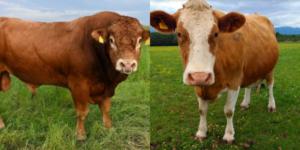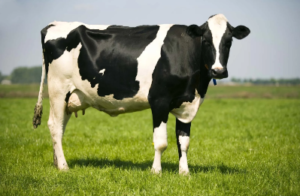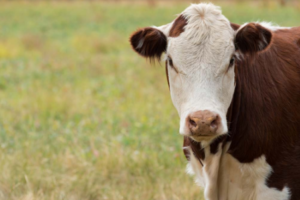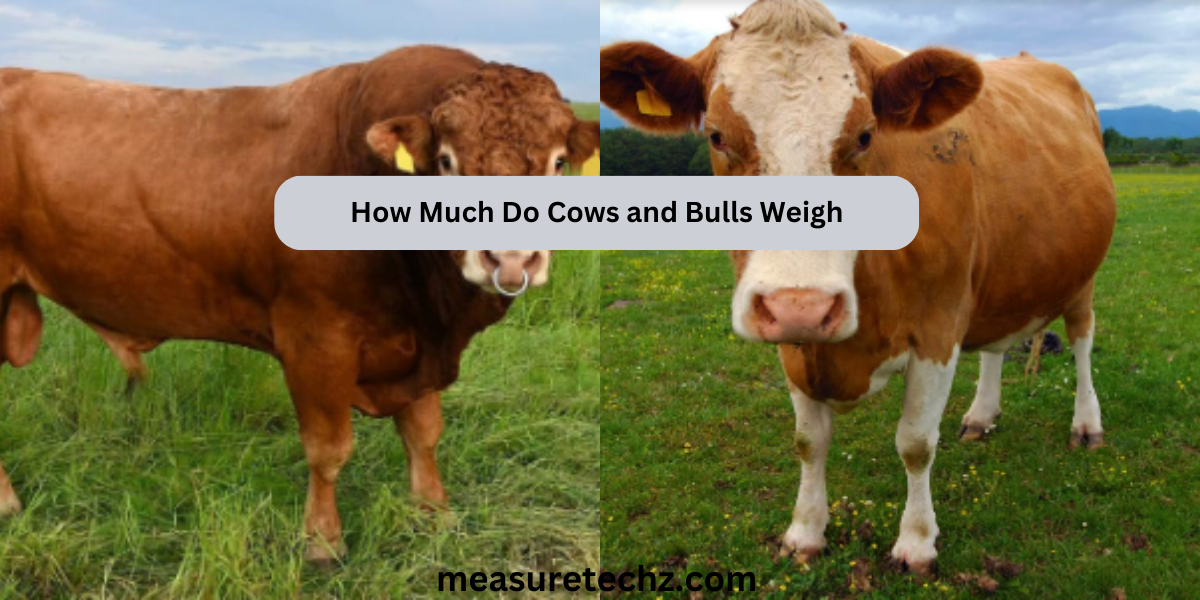Understanding the weight of cows and bulls is essential for farmers, ranchers, and live stock enthusiasts alike. Whether you’re involved in agriculture or simply curious about these magnificent animals, knowing their weight plays a crucial role in their care, management, and overall well-being. This guide provides an in-depth look at how much do cows and bulls weigh, including factors that influence their weight, breed-specific differences, and practical tips for weight management.
How Much Do Bulls Weigh Compared to Cows? A Simple Guide
Bulls are usually much heavier than cows, even when they’re the same breed. How much do Cows and Bulls Weigh a few hundred kilograms more. Take British Hereford cattle as an example female cows typically weigh between 600 to 800 kilograms (around 1,300 to 1,800 pounds). But the males, or bulls, are much larger, often weighing between 1,000 to 1,200 kilograms (2,200 to 2,600 pounds).
Interestingly, beef cattle used to be much smaller in the past. Before the year 1790, an average beef cow would weigh only about 160 kilograms (350 pounds). That’s less than a third of the weight of today’s bulls!
Why Knowing the Weight of Cows and Bulls Matters

The weight of cows and bulls impacts various aspects of their care and use, including:
- Health Management: Monitoring weight helps identify potential health issues like malnutrition or obesity.
- Feed Requirements: Proper weight estimates ensure that livestock receive adequate nutrition.
- Breeding Programs: Knowing the weight is vital for selecting ideal breeding pairs.
- Transportation and Trade: Accurate weight measurements are essential for legal transport and determining market value.
Understanding these factors ensures optimal care and productivity of cattle.
Average Weight of Cows and Bulls
The average weight of cows and bulls varies based on their breed, age, gender, and purpose (e.g., dairy vs. beef). Below is a general overview:
Dairy Cattle

Dairy cows tend to have lower weights compared to beef cattle, as their primary purpose is milk production rather than meat.
| Breed | Average Cow Weight | Average Bull Weight |
|---|---|---|
| Holstein | 1,500 lbs (680 kg) | 2,200 lbs (998 kg) |
| Jersey | 1,000 lbs (453 kg) | 1,500 lbs (680 kg) |
| Guernsey | 1,200 lbs (544 kg) | 1,800 lbs (816 kg) |
Beef Cattle

Beef cattle are bred primarily for meat production, so they tend to weigh more than dairy breeds.
| Breed | Average Cow Weight | Average Bull Weight |
| Angus | 1,200 lbs (544 kg) | 1,800 lbs (816 kg) |
| Hereford | 1,300 lbs (590 kg) | 2,000 lbs (907 kg) |
| Charolais | 1,600 lbs (726 kg) | 2,500 lbs (1,134 kg) |
Other Factors Impacting Weight
- Calves: At birth, calves typically weigh between 50-100 lbs (22-45 kg), depending on the breed.
- Steers: Castrated male cattle (steers) often weigh less than bulls but more than cows.
Factors That Influence Cattle Weight
Several factors contribute to the weight of cows and bulls:
1. Breed Genetics
Different breeds have distinct genetic predispositions that determine their size and weight. For example, Holstein cows are larger than Jersey cows, and Charolais bulls are among the heaviest.
2. Age
- Calves: Birth weight varies by breed, with rapid weight gain during the first few months.
- Mature Cattle: Full-grown cows and bulls reach their peak weight by 4-5 years of age.
3. Diet and Nutrition
Proper nutrition directly impacts weight gain and overall health. High-quality forage, grains, and supplements ensure optimal growth.
4. Environment
- Climate: Cold climates may require cattle to store more fat for insulation, increasing weight.
- Grazing Conditions: Access to nutrient-rich pastures promotes healthy weight gain.
5. Purpose (Dairy vs. Beef)
Dairy cattle are typically leaner to prioritize milk production, while beef cattle are bred for maximum muscle mass.
How to Measure the Weight of Cows and Bulls
Accurately measuring cattle weight is essential for proper management. Here are the most common methods:
1. Weighing Scales
- Livestock Scales: Provide the most accurate measurements but can be expensive.
- Portable Scales: Useful for farms with smaller herds.
2. Weight Tapes
- A cost-effective method involving a specially marked tape used to measure the heart girth.
- Less accurate than scales but sufficient for estimating weight.
3. Visual Assessment
Experienced farmers can estimate weight based on the animal’s build, but this method is subjective and less reliable.
Tips for Managing Cattle Weight
Maintaining an ideal weight is crucial for the health and productivity of cows and bulls. Here are some tips:
1. Regular Monitoring
- Weigh cattle periodically to track changes and adjust feeding programs as needed.
- Use technology like automated feeders with weight sensors.
2. Provide Balanced Nutrition
- Combine high-quality forage with grains and supplements tailored to the animal’s needs.
- Consult a livestock nutritionist for optimal feeding strategies.
3. Ensure Adequate Exercise
- Provide ample space for grazing and movement to prevent obesity.
- Avoid overfeeding confined cattle.
4. Monitor Health Conditions
- Regular veterinary check-ups help identify weight-related health issues such as bloat or metabolic disorders.
- Deworm cattle routinely to prevent weight loss caused by parasites.
Conclusion
The weight of cows and bulls is influenced by various factors, including breed, age, and diet. Whether you’re raising dairy or beef cattle, understanding these differences and monitoring weight effectively ensures healthier, more productive livestock. By following best practices in nutrition, health management, and weight monitoring, you can optimize your herd’s performance and well-being.

